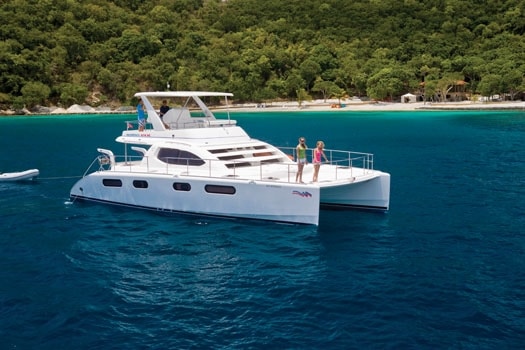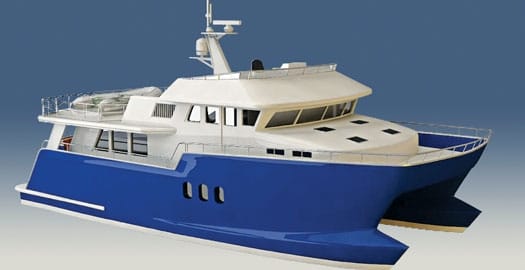
Power Catamarans
In the timeline of all things nautical, the power catamaran is a recent addition but, to hear its proponents, you’d think it was the best thing since, well, clap lights. Power cats seem to offer the impossible: more space for a given length, more speed with less expensive engines, and less fuel consumption.
If those features are true, then why hasn’t the world embraced the power catamaran? Instead, it remains basically a cottage industry.
There are a lot of reasons that power cats remain a sidebar to “real boats,” not the least of which is that a lot of manufacturers have a lifetime supply of very expensive molds for single-hulled powerboats, hence a natural reticence to disturb the status quo. For the most part, the builders of power catamarans remain as a small band of zealous missionaries intent on sharing their wisdom with the monohull heathens.
Catamarans, of course, aren’t a new phenomenon, with records of them as early as 5th Century India. And, at a time when most of the “civilized” world was still gazing at the sea with fear, the Polynesians were making incredible voyages over thousands of miles of open ocean aboard catamarans.
Nathanael Herreshoff designed a racing catamaran in 1876, which (no surprise) was promptly banned by the New York Yacht Club because it was too fast. After World War II, the Hawaiian beach catamaran, Manu Kai, took decades of tourists through the surf off Waikiki to kick-start the sailing catamaran craze that eventually attracted surfer Hobie Alter, whose ubiquitous Hobie Cats now number more than 100,000.
Larger cruising catamarans have been slow to develop, in part because many of the early designs might best be described as clunky, since they were often based on the characteristics of a 4-by-8-foot sheet of plywood.
As designs improved with the development of fiberglass construction methods, the Caribbean charter industry shifted from one based strictly on monohulls to the point where catamarans, both sail and power, fill many fleets. These, in turn, have introduced more yachtsmen to the pleasures of the catamaran.
A prime selling point for power cats is that they offer a surprising amount of space for their length. Of course, it doesn’t take a naval architect to figure out that a 42-foot catamaran with a beam of 22 feet is going to have more available space than a 42-foot monohulled powerboat with a beam of 13 feet. Duh.

| | |
The catamaran also solves some of the layout problems of a single- hulled yacht by allowing the cabins to be well spaced in the two hulls, thus providing a level of privacy unavailable when cabins are separated only by a thin bulkhead. There is, however, a downside. Because the hulls are fairly narrow, the space available for cabins in the hull is constrained, so designers have resorted to some unusual layouts, such as creating raised berths that are tucked into the bridge deck to free up floor space.
Those lean hulls also create less drag than a single hull, giving power cats both better speed and better fuel economy, all other things being equal. Power cats are effective with smaller and lighter engines, which also helps reduce the operating costs.
When it comes to “feel,” well, a power catamaran is another breed of cat. (I had to get that line in somewhere!) Catamarans just feel different than single-hulled yachts, both at sea and at anchor. The greater beam and two-legged stance can give the anchored catamaran a steadiness that rivals solid ground. At sea, a power cat has a quick loping motion that many find to be more agreeable than that of a slow-to-react monohull.
To be fair, that wide beam does come with some penalties. You may find that marinas aren’t able to fit you into a slip, or you may be hit with a surcharge for a larger slip or an end tie. And when it comes time to haul for bottom paint or service, some shipyards aren’t able to handle that wide beam.
One thing that skippers new to power cats quickly discover is that because the twin hulls have a smaller “footprint,” they are much more sensitive to weight. Pile on as much gear as you would on a monohull, and the boot top of a power cat will disappear.
Nevertheless, a growing number of cruisers are considering making the switch to power catamarans that give them speed, space, and reduced costs.
In the evolving power cat market, there are motoryachts, sportfishers, express cruisers, trawlers, and even megayachts in catamaran form. And, because catamaran design remains relatively young, there is a lot of experimentation not found in the mature monohull field. You’ll find power cats with hydrofoils, power cats that rely on solar energy for propulsion, and power cats that have faux bows so they look like monohulls above the water.
Since some power cats are intended for open ocean crossings while others are strictly coastal cruisers, you should consider your choices carefully. This is still a relatively new market segment, so complete your due diligence before signing on the dotted line. Evaluate what you need and want in a yacht, examine the builder’s credentials, talk to power cat owners, and take your time. You may find a power catamaran that offers everything you’re looking for in your next yacht
| Cats’ Eye ******Here’s a look at some current power cats.** ******AFRICAT:** As the name implies, this is a South African company building 32-, 42-, and 58-foot power cats. These are the only power cats with Volvo Penta IPS joystick power at this time. www.africatmarine.com BEARCAT: The first of the BearCat 46 power cats has been delivered, and a 51-footer is on the drawing boards of this Chinese builder. www.cruisingcatusa.com BLUBAY: In addition to huge sailing cats, this French builder offers the Blubay TC 45, a high performance hydrofoil cat in open, cruiser, and sportfish styles. www.aeroyacht.com DEFIANT: From Florida, this high performance 49-foot by 11 1⁄2-foot cat has a monohull-like bow and is available in several configurations. www.defiantmarine.com DESTINY: This 42-footer was designed by Greg Marshall and is being built in the Pacific Northwest with Yanmar power. Layouts with two to four staterooms are available. www.cruisingcatusa.com ENDEAVOUR: This experienced Florida builder offers a range of TrawlerCats from 36 feet to 48 feet, including skylounge and pilothouse versions. www.endeavorcats.com FOUNTAINE PAJOT: This well-known French company has four fiberglass power cats from 35 feet to 55 feet, including the new Summerland 40 motoryacht. www.fountain-pajot.com H2X: This French custom builder has launched the Mcat 88, an aluminum power cat and is building the Mcat 100 mega-cat. www.h2x.com ISLAND PILOT This 39 1/2-foot power cat is unique for its diesel-electric power, allowing it to cruise at 6 knots using either solar or generator/battery power. www.dsehybrid.com LEOPARD: The sleek new Leopard 47 is a Morrelli and Melvin design with either 3 or 4 cabins and a spacious flying bridge. Available for private purchase or for a charter-ownership program. www.moorings.com/leopardcatamarans MAINE CAT: This Down East builder has built more than 100 sailing catamarans, and is now finishing the first P-47, a 47-foot power catamaran with an 18-foot beam. www.mecat.com MANTA: A successful builder of sailing catamarans, Manta adapted their attributes to the 44-foot PowerCat for liveaboard or cruising. www.mantacatamarans.com MELIAHN CUSTOM YACHTS: The Gemini 52 SuperSport uses two Arneson Surface Drives matched to two 900-horsepower turbocharged Yanmar V-8s to give it a top speed of over 50 mph. www.geminisupersport.com PACIFIC EXPEDITION: This Pacific Northwest builder is building power cats from 45 feet to 65 feet with bulbous bows and fully enclosed pilothouses. www.pacificexpedition.com PDQ: This builder of 34- and 41-foot models has been acquired by Pearson Composites, builder of True North powerboats. Future PDQs will be built using SCRIMP infusion. www.pdqyachts.com PORTSMOUTH: Famed sailor and yacht designer Ted Hood has created a line of offshore power cats in 47-, 52-, and 62-foot lengths. www.portsmouthmarine.com STEALTH: This South African builder features hydrofoils between the hulls on its 540 motoryacht and 520 express cruiser. www.stealthyachts.com SUNBOATS: This Brazilian builder offers mega power cats from 83 to 155 feet, with features such as helipads and the ability to beach the yacht. www.sunboats.com.br SUNREEF: Just launched from this Polish builder of large sailing cats is their first power cat, a 70-by-30-foot expedition yacht for world cruising. www.sunreef-yachts.com VG SHIPYARDS: This Italian builder offers a four-stateroom version of their 62-foot power cat as well as a three-cabin layout with the master suite filling one entire hull. www.brbyachts.com |









